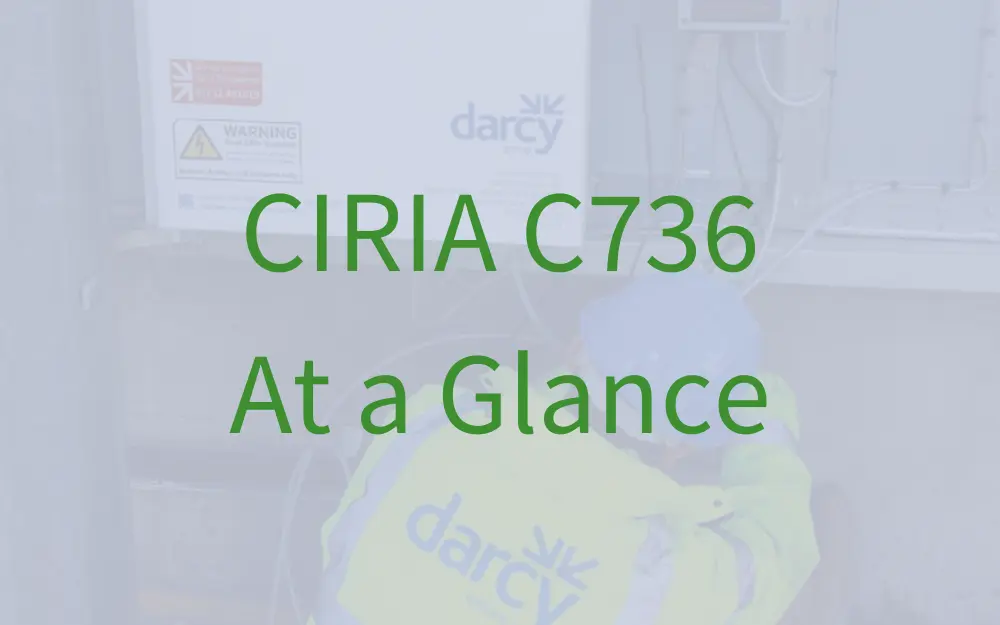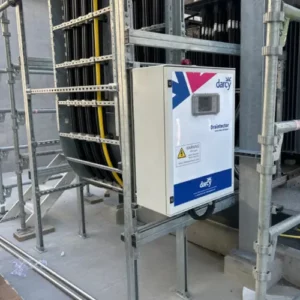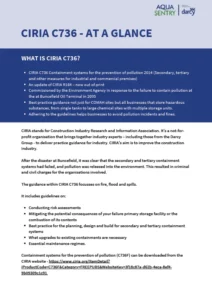
What Is CIRIA C736?
- CIRIA C736 Containment systems for the prevention of pollution 2014 (Secondary, tertiary and other measures for industrial and commercial premises)
- An update of CIRIA R164 – now out of print
- Commissioned by the Environment Agency in response to the failure to contain pollution at the Buncefield Oil Terminal in 2005
- Best practice guidance not just for COMAH sites but all businesses that store hazardous substances, from single tanks to large chemical sites with multiple storage units
- Adhering to the guidelines helps businesses to avoid pollution incidents and fines.
CIRIA stands for Construction Industry Research and Information Association. It’s a not-for- profit organisation that brings together industry experts – including those from the Darcy Group – to deliver practice guidance for industry. CIRIA’s aim is to improve the construction industry.
After the disaster at Buncefield, it was clear that the secondary and tertiary containment systems had failed, and pollution was released into the environment. This resulted in criminal and civil charges for the organisations involved.
The guidance within CIRIA C736 focusses on fire, flood and spills.
It includes guidelines on:
- Conducting risk assessments
- Mitigating the potential consequences of your failure primary storage facility or the combustion of its contents
- Best practice for the planning, design and build for secondary and tertiary containment systems
- What upgrades to existing containments are necessary
- Essential maintenance regimes.
Containment systems for the prevention of pollution (C736F) can be downloaded from the CIRIA website.
Why Is It Important?
Businesses must comply with relevant legislation, but it is not always easy to interpret the law and understand what you need to do to comply with it. That’s where CIRIA C736 comes in.
CIRIA C736 relates to the following UK legislation:
- The Environmental Permitting (England and Wales) Regulations 2016, and The Pollution Prevention and Control (Scotland) Regulations 2012
- The Control of Pollution (Oil Storage) (England) Regulations 2001, The Water Resources (Control of Pollution) (Oil Storage) (Wales) Regulations 2016, The Water Environment (Oil Storage) (Scotland) Regulations 2006, and The Control of Pollution (Oil Storage) Regulations (Northern Ireland) 2010
- Pollution Prevention and Control Act 1999
- Control of Major Accident and Hazards (COMAH) Regulations 2015.
If a spill or other pollution incident occurs, regulators will not just check if legislation has been followed. They will scrutinise your systems and processes to ensure that good practice guidance has been implemented.
Embracing recognised standards, such as C736, demonstrates to regulators that operators are doing everything practicable to reduce risks. It also provides peace of mind that operations are done safely and securely.
Pollutants can escape and cause harm to the environment if containment units are not planned or built properly or maintained regularly. Pollution harms the local ecosystem, and its effects can be felt for years to come.
Not complying with CIRIA C736 can hugely increase potential fines in the event of a pollution incident. You also have the other potential negative economic consequences of the operational impact of downtime required to facilitate the cleanup and the impact on your company’s reputation.
Following best practice guidelines and implementing changes to ensure compliance will also help tick those all-important boxes during an ISO 14001 audit, which looks for improvements that have been made.
Tertiary Containment From Darcy

If all else fails, you need to ensure that spilled pollutants or firewater runoff are contained on-site. Aquasentry, a division of the Darcy Group, designs bespoke drain closure systems using its UK-manufactured drain closure devices.
Draintector can be activated manually, remotely or automatically by fitting one or all of pH, turbidity or odour sensors, or linking it to your fire alarm for immediate remote closure.
Automated activation removes the human element. There’s no lag between the issue occurring, it being noticed and the drain closure device activating. And, particularly in the event of a fire, when you need to ensure the safety of your personnel, you do not need to send someone in to press the button.
Four Steps to Compliance With CIRIA C736
- Make sure all secondary and tertiary containment systems are properly specified
- Implement a thorough inspection programme for these systems, including both regular and detailed periodic inspections, following the relevant standards and best practice guidelines
- Promptly address any defects or non-conformances or establish an appropriate improvement plan
- Collaborate with an environmental partner to guide you through the necessary inspection and maintenance regimes, ensuring your sites remain compliant.
Get in Touch With Our Experts
If spill containment and CIRIA736 compliance is currently a consideration for you, don’t hesitate to get in touch with us, and we will be happy to discuss our solutions with you.

Sign up for the latest news and offers


